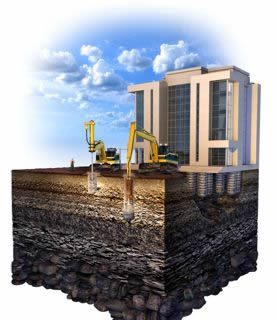

Webmaster: Stansfeld, LLC. |
|
|

APRIL 2010 MEETING
Wednesday, April 14, 2010
TECHNICAL
PROGRAM
Introduction to Geopier System
Speaker: Gerry Kehler, P.E. with Geopier in Marietta, GA, Tel. 770-422-2232
Mr. Kehler is a professional engineer with 16 years of experience in geotechnical engineering, specializing in geosythetic applications and geotechnical construction methods. He has spent 15 years working with Tensar International Corporation, the parent company of Geopier Foundation Company. Mr. Kehler is a licensed professional engineer in Georgia and Alabama, and the Canadian province of Alberta. He is currently in the process of moving to Texas and registering as a PE in Texas.
PRESENTATION SUMMARY
 To a room of about 60 at the HESS Club, Mr. Kehler gave a presentation titled, "Introduction to Geopier System." His presentation centered on the rammed aggregate pier types which are intermediate depth foundations often used for ground improvement. The system was developed in the early '90's for use in conditions where the near-surface soils are neither very bad nor very good. He said the system works best in sands and gravels and does not work well in very soft soils, particularly if the design gravity loads are high.
To a room of about 60 at the HESS Club, Mr. Kehler gave a presentation titled, "Introduction to Geopier System." His presentation centered on the rammed aggregate pier types which are intermediate depth foundations often used for ground improvement. The system was developed in the early '90's for use in conditions where the near-surface soils are neither very bad nor very good. He said the system works best in sands and gravels and does not work well in very soft soils, particularly if the design gravity loads are high.
The construction process for a Rammed Aggregate Pier (RAP) begins by augering a hole 24 to 30 inch diameter by 22 to 25 ft deep. Then well graded aggregate (up to 3/4 inch) is placed in 12- to 24-inch lifts, and each lift is compacted with a hydraulic ram. The ram causes ground vibrations similar to that of a bulldozer. Mr. Kehler said it is only necessary to stay 3 to 4 ft away from existing structures. A crew can install 40 to 100 RAP elements a day. Retrievable casing is used where hole caving is a possibility.
Displacement type driving is an option also where soils are soft. In this case a drive mandrel forces an open hole like a displacement pile does, by impact driving to penetration. Next the mandrel is pulled up 3 ft and aggregate is conveyed below and through the mandrel. The mandrel then drives the 3 ft of aggregate into a dense and bulging 1 ft lift.
Mr. Kehler said that RAP's can be located on a tight grid when supporting shallow footings and storage tank loads. This is done when the strip or spread footings need to be limited in plan area, in soft soils were large settlements cannot be tolerated. He said the key to their RAP's success is the very low void ratio achieved in their ramming process as well as the large lateral effective stress they achieve by ramming the aggregate with a point beveled tamper foot, which forces the aggregate to radially bulge. The bulging configuration provides skin friction to complement the end bearing.
Mr. Kehler noted that Geopier does a test pier on every project. They install a telltale system at the shoe with a sleeved rod to the surface. Then the pier is loaded at the head and deflection is measured at the head and shoe. Horizontal steel plates can be installed at the shoe with corner rods that run the length of the shaft and are later connected to the footing above to attain up to 50,000 lbs. of uplift resistance. Significant lateral resistance is also available because of the high friction angle in the aggregate after ramming, usually on the order to 48 to 52 deg.
Mr. Kehler presented several case histories that are available in his slides. To download his slide presentation, click here.
|



